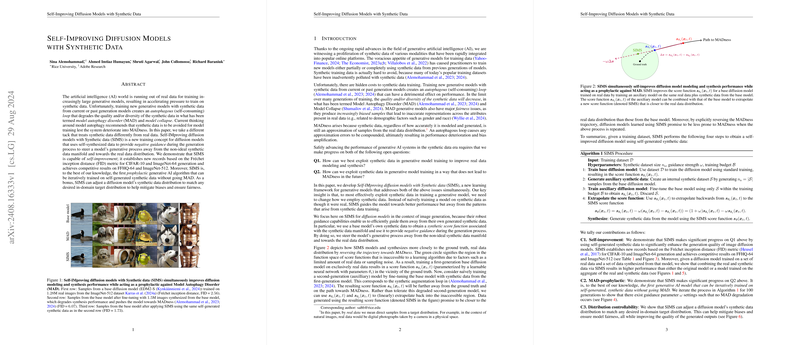Analysis of "Self-Improving Diffusion Models with Synthetic Data"
The paper "Self-Improving Diffusion Models with Synthetic Data" presents a compelling method for addressing the challenges associated with limited real-world data in training generative AI models, particularly diffusion models. The approach, aptly named Self-IMproving diffusion models with Synthetic data (SIMS), innovatively incorporates synthetic data into the training process to improve both the fidelity and robustness of the generated outputs without succumbing to known pitfalls such as Model Autophagy Disorder (MAD).
Overview
The core problem addressed in the paper is the insufficient availability of real training data to feed generative models' escalating hunger. Traditionally, employing synthetic data generated by previous iterations of models results in a recursive degradation of data quality—termed as MAD or model collapse. The prevailing thought discourages the use of synthetic data in model training, citing a relentless loop of deteriorating quality known as an autophagous loop.
This paper challenges that notion through SIMS, which implements a novel strategy for negative guidance. By steering the model's generation process away from its synthetic output and guiding it toward the real data distribution, SIMS effectively utilizes synthetic data without inducing MADness. This is achieved by forming a score function that adjusts the model's learning trajectory via synthetic scores, thus balancing between internal data generation and external real data alignment.
Key Components
- Negative Guidance: The paper introduces a mechanism for negative guidance, influencing the model to avoid pathways resultant from synthetic data, typically associated with overfitting to inaccuracies in the data manifold derived from prior iterations.
- Empirical Validation: Extensive empirical validation demonstrates SIMS' effectiveness in maintaining or improving model performance over successive iterations, preventing the decline usually observed due to synthetic data contamination. For instance, SIMS sets new benchmarks in the Fréchet inception distance (FID) for CIFAR-10 and ImageNet-64 datasets, highlighting significant improvements.
- MAD Prevention: The method offers mechanisms to pre-emptively curb the effects of MADness. The paper delineates methodologies to ensure that even with iterative synthetic training, models do not degrade from their original performance, effectively establishing SIMS as a MAD-prophylactic.
- Distribution Shift Capabilities: Additionally, SIMS can shift the synthetic data distribution to align with desired targets. This is illustrated with the capability to modify demographic distributions in datasets like FFHQ-64, showing potential for bias mitigation in AI applications.
Implications and Future Directions
The theoretical underpinnings and empirical robustness of SIMS direct towards broader implications in AI. Notably, the method suggests a safe path forward for leveraging synthetic data in the era of constrained real-world data resources, which could facilitate the scalable development of generative models. Furthermore, SIMS' adaptability to enforce distributional fairness indicates avenues for addressing critical socio-ethical AI concerns.
The practical implications include improved performance of generative models across a variety of tasks without compromising fairness or diversity. The technique could expand to different model architectures beyond diffusion models, perhaps using alternative guidance strategies suited for GANs or VAEs.
Conclusion
In conclusion, "Self-Improving Diffusion Models with Synthetic Data" articulates a prudent approach to navigating the synthetic data conundrum in generative model training. By providing a robust framework that promises self-improvement without succumbing to the degenerative loops of MADness, SIMS potentially redefines the narrative around synthetic data utilization in AI development. Future explorations could delve into extending SIMS principles across other domains and verifying its efficacy in broader real-world scenarios.
